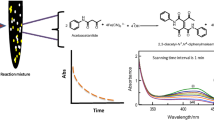Abstract
In EDTA solutions with pH ∼5 at 25°C, Am(V) in a concentration of 5 × 10−4−3 × 10−3 M slowly transforms into Am(III). The Am(V) reduction and Am(III) accumulation follow the zero-order rate law. In the range 60–80°C, the reaction is faster. In some cases, an induction period is observed, disappearing in acetate buffer solutions. In the range pH 3–7, the rate somewhat increases with pH. In an acetate buffer solution, an increase in [EDTA] accelerates the process. The activation energy is 47 kJ mol−1. Zero reaction order with respect to [Am(V)] is observed in solutions of ascorbic and tartaric acids, of Li2SO3 (pH > 3), and of hydrazine. The process starts with the reaction of Am(V) with the reductant. The Am(III) ion formed in the reaction is in the excited state, *Am(III). On collision of *Am(III) with Am(V), the excitation is transferred to Am(V), and it reacts with the reductant: *Am(V) + reductant → Am(IV) + R1 and then Am(IV) + reductant → *Am(III) + R1, Am(V) + R1 → Am(IV) + R2. A branched chain reaction arises. The decay of radicals in side reactions keeps the system in the steady state; therefore, zero reaction order is observed.
Similar content being viewed by others
References
Runde, W.H. and Schult, W.W., The Chemistry of the Actinide and Transactinide Elements, Morss, L.R., Edelstein, N.M., Fuger, J., and Katz, J.J., Eds., Springer, 2006, vol. 2, pp. 1265–1395.
Nikolaevskii, V.B., Shilov, V.P., and Krot, N.N., Radiokhimiya, 1974, vol. 16, no. 1, pp. 61–66.
Clark, D., Hecker, S.S., Jarvinen, G.D., and Neu, M.P., The Chemistry of the Actinide and Transactinide Elements, Morss, L.R., Edelstein, N.M., Fuger, J., and Katz, J.J., Eds., Springer, 2006, vol. 2, pp. 813–1264.
Anderegg, G., Helv. Chim. Acta, 1967, vol. 50, no. 8, pp. 2333–2340.
Nikolaevskii, V.B., Shilov, V.P., and Krot, N.N., Radiokhimiya, 1973, vol. 15, no. 6, pp. 871–872.
Woods, M., Montag, T.A., and Sullivan, J.C., J. Inorg. Nucl. Chem., 1976, vol. 38, no. 11, pp. 2059–2061.
Kabanova, O.L., Danuschenkova, M.A., and Paley, P.N., Anal. Chim. Acta, 1960, vol. 22, pp. 66–75.
Shastri, N.K. and Amis, E.S., Inorg. Chem., 1969, vol. 8, no. 11, pp. 2484–2486.
Pikaev, A.K., Shilov, V.P., and Gogolev, A.V., Usp. Khim., 1997, vol. 66, no. 9, pp. 845–873.
Shilov, V.P., Radiokhimiya, 1985, vol. 27, no. 5, pp. 581–584.
Coleman, J.S., Inorg. Chem., 1963, vol. 2, no. 1, pp. 53–57.
Luzan, A.A. and Yatsimirskii, K.B., Zh. Neorg. Khim., 1968, vol. 13, no. 12, pp. 3216–3222.
Kazakov, V.P., Khemilyuminestsentsiya uranila, lantanidov i d-elementov (Chemiluminescence of Uranyl, Lanthanides, and d Elements), Moscow: Nauka, 1980.
Author information
Authors and Affiliations
Corresponding author
Additional information
Original Russian Text © A.M. Fedoseev, V.P. Shilov, N.B. Nikolaevskii, 2012, published in Radiokhimiya, 2012, Vol. 54, No. 4, pp. 302–306.
Rights and permissions
About this article
Cite this article
Fedoseev, A.M., Shilov, V.P. & Nikolaevskii, N.B. Specific features of reactions of Am(V) with reductants in weakly acidic solutions. Radiochemistry 54, 330–334 (2012). https://doi.org/10.1134/S1066362212040030
Received:
Published:
Issue Date:
DOI: https://doi.org/10.1134/S1066362212040030



